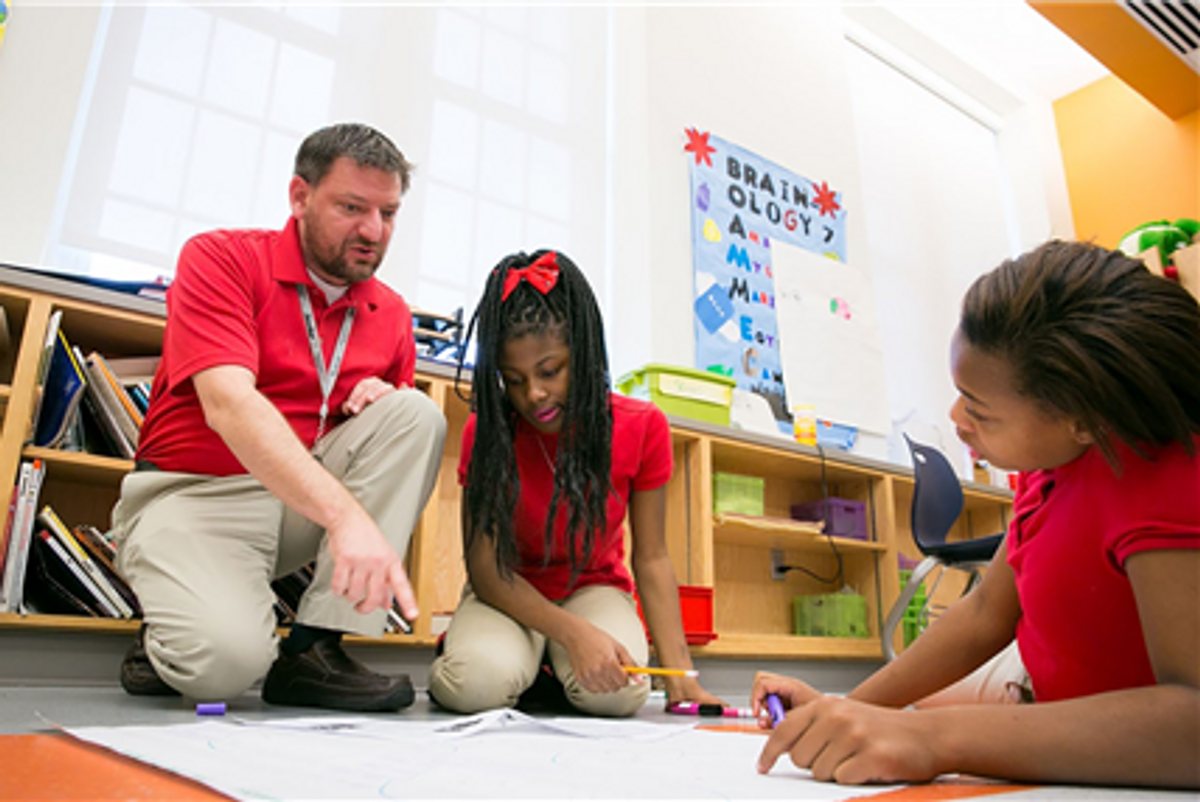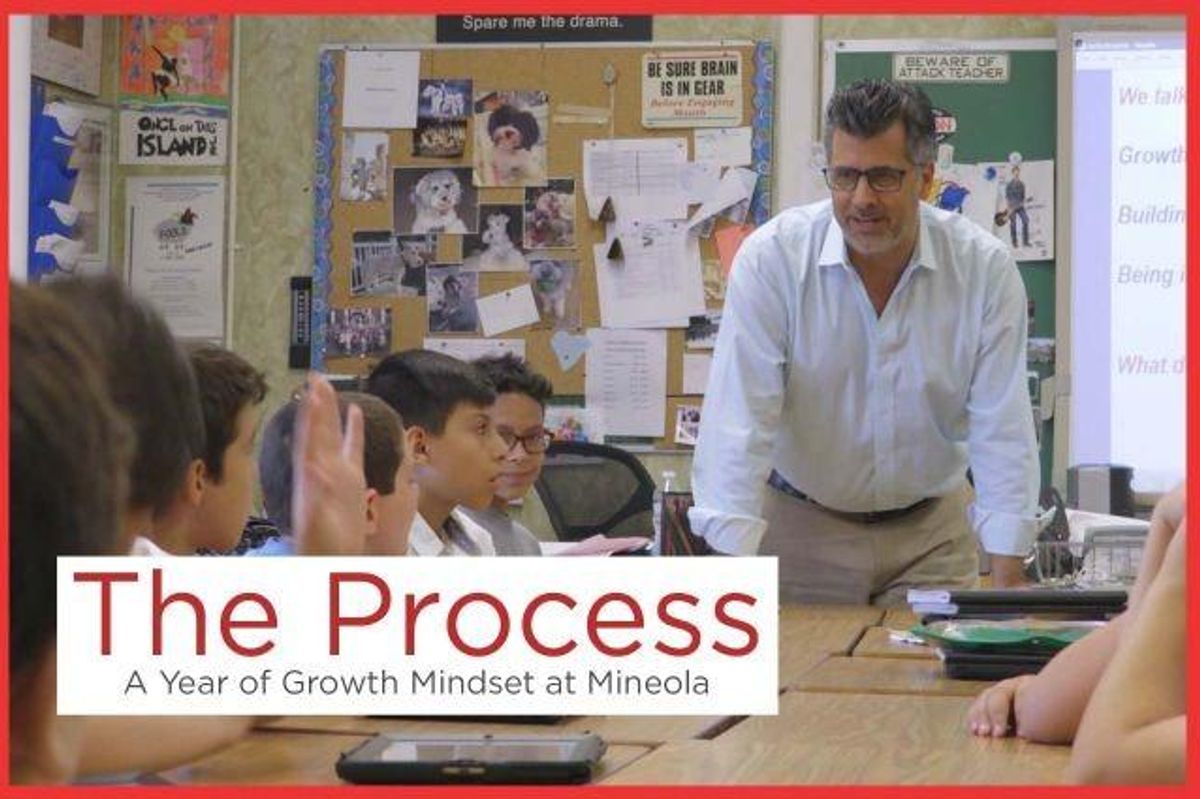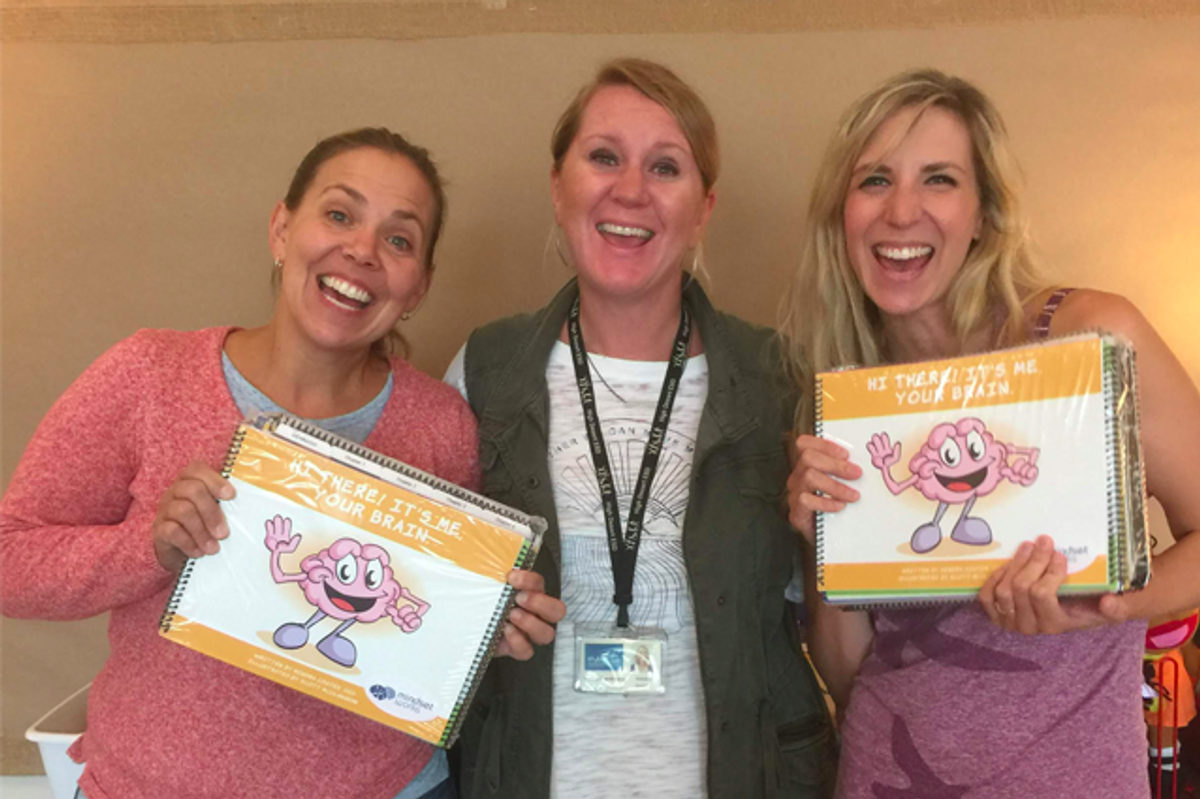A celebrated teacher's 5-point explanation of why she's quitting has gone viral.
"The school system is broken. It may be broken beyond repair."
Talented, dedicated teachers are leaving public schools because the system makes it too hard to truly educate kids.
When I studied to become a teacher in college, I learned what education can and should be. I learned about educational psychology and delved into research about how to reach different learners, and couldn't wait to put that knowledge into practice in the classroom.
But after graduating and starting to teach, I quickly saw how the school system makes it almost impossible to put what we know about real learning into practice. The structure and culture of the system simply isn't designed for it.
The developmental default of childhood is to learn. That's why four-year-olds ask hundreds of questions a day, why kids can spend hours experimenting and exploring in nature, and why kids are so much better at figuring out how to use technology. Children are natural, fearless learners when their curiosity is nurtured and they are given an environment where learning can take place.
Most teachers know this. And many find themselves so frustrated by trying to teach within an outdated, ineffective system that they decide to leave. I only lasted a couple of years before deciding other avenues of education were worth exploring. A viral post written by a celebrated teacher highlights why many teachers are doing the same thing.
Michelle Maile was a first grade teacher before she resigned this month, and her 5-point explanation of why she did it is resonating with thousands.
Maile shared on Facebook why she, a celebrated teacher in a great school district, decided to turn in her classroom keys. Her post has been shared more than 67,000 times and has thousands of comments, mostly in solidarity.
"Why would a teacher of the year nominee, who loves what she does, who has the best team, the best students and parents, and was lucky enough to be at the best elementary school not want to come back?", she wrote. "Let me tell you why….
1. Class size. Everything in my training, what I know about kids and what I see every day says that early childhood classes should be at 24 or less. (ideally 22 or less) Kids are screaming for attention. There are so many students who have social or emotional disorders. They NEED their teacher to take time to listen to them. They NEED their teacher to see them. They NEED less students in their class. The people making these decisions are NOT looking out for the students' best interests, and have very obviously NEVER taught elementary kids.
2. Respect. I feel disrespected by the district all year long. They don't trust that I know what I am doing. I have a college degree, go to trainings every year, read books and articles about kids, and most importantly, work with kids every day. I KNOW something about how they learn and what works best for them. Please listen to us.
3. Testing. Stop testing young kids. It doesn't do anyone any good. Do you know which kids slept poorly last night? Do you know who didn't have breakfast? Do you know whose parents are fighting? Do you know who forgot their glasses and can't see the computer? Do you know who struggles to read, but has come so far, just not on your timeline? You don't, but I do. I know some of my best students score poorly on their tests because of life circumstances. I know some of my lower students guessed their way through and got lucky. Why stress kids out by testing them? How about you ask ME, the professional, how they are doing? Ask ME, the teacher who sees these kids every single day. Ask ME, the teacher who knows the handwriting of all 27 kids. Ask ME, the adult in their life who may be more constant than their own parents. Ask ME, then let me teach.
4. I felt like I was drowning. So many things beyond teaching are pushed on teachers. Go to this extra meeting, try this new curriculum, watch this video, then implement it in to your next lesson, fill out this survey monkey to let us know how you feel (even though it won't make any difference), make clothes for the school play, you need to pay for that yourself because there's no money from the school for it. There's no music teacher today, so you don't get a planning time. There are weeks I truly felt like I was drowning and couldn't get a breath until Friday at 5:00. (NOT 3:00)
5. Pay. I knew becoming a teacher would never make me rich. That has never been my goal. I wanted to work with kids. I wanted to help kids. I wanted to make enough money to take care of my own kids. Sadly this isn't the case for so many teachers who have to work two jobs to support their own families. This isn't right."
Maile says the system may be broken beyond repair, which is why she's tapping into a growing educational movement.
"The school system is broken," Maile continued. "It may be broken beyond repair. Why are counselors being taken away when we need them more than ever? Why are art and music classes disappearing when these forms of expression have been proven to release stress in an overstressed world. Why are librarians being cut when we should be encouraging kids to pick up an actual book instead of being behind a screen? Do you know how many elementary students are on anti-anxiety and anti-depression medications? Look. The number will astound you.
So where am I going? Because I still love kids and want to help them with their education, I will be an online charter school teacher. I will be helping families who have chosen to homeschool their kids. They also see that the school system is broken. When I told my school I was leaving, I had multiple veteran teachers say, 'I would do the same if I was younger.' 'I am so glad you are getting out now.' 'It is only going to get worse.' 'I don't see it ever getting better.'
It makes me sad. I have three kids that are still part of this public school system. If you are a public school parent, fight. Fight for your kids. Fight for smaller class sizes and pay raises for overworked teachers. Fight to keep art and music in the schools. Please support teachers whenever and wherever you can. I have been so lucky to have so many amazing parents. I couldn't have done what I have without them. I am sad to leave, but happy to go."
What do you do when an enormous system has so many inherent flaws it feels impossible to change it?
What to do about public education a hard question. Many former teachers like myself strongly believe in public schooling as a foundational element of civilized society, but simply can't see how to make it work well without dismantling the whole thing and starting over.
When I chose to educate my own kids, I was surprised by how many former teachers end up in the homeschooling community. Many of the most well-known proponents of homeschooling were or are public school teachers who advocate for more effective models of education than what we see in the system. There's a lot that could be debated here, but alternative models may be the best places to look for answers to the question of how to fix the system.
At the very least, until we start moving away from copious amounts of testing and toward trusting educators (and paying them well) to do what they've been trained to do, we're going to keep losing great teachers—making an already problematic system even worse.
This article originally appeared on 6.17.19
- Why Amy Adams' silence on equal pay in Hollywood speaks ... ›
- My daughter's teacher brought her political agenda to the classroom ... ›
- 600,000 kids could've missed a meal with schools closed. But these ... ›
- Dear North Carolina: Arming teachers with guns is a spectacularly ... ›
- There's a historic teachers strike going on across West Virginia ... ›
- These Teacher Appreciation Week tributes are ridiculously ... ›
- Oklahoma's governor compared teachers to bratty teens. We should ... ›
- A teacher asked a great question about superintendent pay. Then ... ›
- In a heartfelt post, an educator shows us exactly how poorly we pay ... ›
- It's long past time for teachers to be compensated for the work they actually do - Upworthy ›
- 89-year-old retired math teacher is still tutoring students - Upworthy ›
- Many families are opting to continue homeschooling this fall - Upworthy ›
- Teacher shares her lesson on fairness using Band-aids - Upworthy ›
- Teachers are quitting in droves, and it's not about the low pay - Upworthy ›
- Stephen Hansell goes from custodian to teacher - Upworthy ›
- So you feel like quitting? Check out Nastia Liukin's advice. - Upworthy ›
- She quit teaching, works at Costco, and has 'never been happier.' That says something. - Upworthy ›
- Teacher who got second job delivering pizzas goes viral - Upworthy ›
- Community supports teacher placed on leave for OnlyFans - Upworthy ›
- High school teacher quits over smartphone addiction - Upworthy ›
- Veteran teacher's touching message to first-year teachers - Upworthy ›
- Fed-up teacher wants to quit school that only cares about students' feelings - Upworthy ›
- Teachers says she runs her classroom like a 'corporate office'—including giving PTO - Upworthy ›
- Yet another school district shifts to 4-day week and parents are sounding off - Upworthy ›
- I asked dozens of teachers why they're quitting. The answers are a heartbreaking must-read. - Upworthy ›
- Teacher-of-the-year nominee's 5-point explanation of why she quit goes viral - Upworthy ›
- Teacher goes above and beyond for a biology lesson by wearing an anatomically correct suit - Upworthy ›





 Teachers spend money to make their classrooms engaging environments.Photo
Teachers spend money to make their classrooms engaging environments.Photo  Teachers in the U.S. usually have small budgets for their classrooms.Photo by
Teachers in the U.S. usually have small budgets for their classrooms.Photo by 






 Image courtesy of Mark Storhaug
Image courtesy of Mark Storhaug Image courtesy of Kaiya Bates
Image courtesy of Kaiya Bates Image courtesy of Julie Tarman
Image courtesy of Julie Tarman